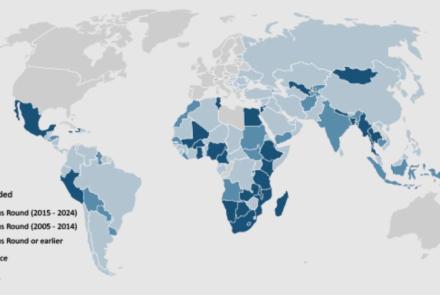Annotated Bibliography: Paid and Unpaid Work
Benes, E., & Walsh, K. (2018). Measuring Employment In Labour Force Surveys: Main findings from the ILO LFS pilot studies: International Labor Organisation.
This report presents the main findings on the measurement of employment drawn from the ILO LFS pilot study project. The report is part of the ILO statistical methodology series that describe in detail the findings of the Project. The full series is available in the website of the ILO Department of Statistics. The report is structured as follows. Section I provides a short overview of the latest international recommendations on the measurement of employment included in the Resolution I adopted by the 19th ICLS. Section II describes the testing strategy and the alternative questionnaire approaches to identify persons employed developed for testing. Section III details the first stage of testing (cognitive interviewing), including the issues evaluated, the main findings and changes introduced to the alternative survey questionnaires as a result. Section IV describes the second stage of testing (experimental field tests), including the issues assessed and findings. The final section (V) provides a summary of the main conclusions and recommendations drawn from the pilot studies.
Buvinic, M., & King, E. M. (2018). Invisible No More? A Methodology and Policy Review of How Time Use Surveys Measure Unpaid Work. Data2x.
While Time Use surveys have gained popularity in recent years, their growing importance for measuring both the new definitions of work and the SDGs have fueled renewed urgency to resolve ongoing methodological issues. The report suggests the following lessons for implementers, policymakers, and supporting institutions:
- Balance the goal of having complete time records using harmonized activity codes against the goal of reducing survey costs by using simpler or focused activity lists.
- Resolve important methodological issues about measuring unpaid employment and household work relating to time of year/day of week when data is collected and particular issues for developing countries such as prevalence of unpaid work, low literacy, lack of use of time pieces, etc.
- Consider social norms and household structures in selecting the survey respondent and interpreting time use patterns.
- Find solutions for measuring and reporting simultaneous or secondary activities that do not overburden respondents.
- Consider fielding linked, repeated surveys over time as these increase the potential policy and research benefits of time use data.
Chadeau, A. (1992). What is a Households' Non-market Production Worth? Paris: Organisation for Economic Co-operation and Development.
This paper deals with the measurement of “non-market production” by house- holds. Non-market production covers the goods and services household members produce for their own consumption by combining their unpaid labour and the goods and services they acquire on the market. The value added generated by these activities is excluded from conventional macro-economic aggregates. The national accounts seem to be saying that household production is worth nothing, but housework both increases the value of purchased goods and services and contributes to the formation and upkeep of human capital. Its value is clearly substantial.
Charmes, J. (2018). The unpaid care work and the labour market. An analysis of time use data based on the latest world compilation of time-use surveys.
This publication is part of a series of research papers that was commissioned as background research for the major ILO report Care work and care jobs for the future of decent work. It provides a comprehensive overview of the extent, characteristics and historical trends of unpaid care work based on the analysis of the most recent time-use surveys carried out at the national level across the world. By discussing the concepts and methodological approaches which underlie the analysis of time-use data, this research paper shows the differences in time spent on unpaid care work between women and men and among people with different socioeconomic characteristics: geographical location, age group, educational level, activity status, employment status, income group, marital status and presence and age of children in the household.
Desai, S. (2013). Women in Workforce: Burden of Success, Decline in Participation. Yojana, 57, (56-59).
Despite rapid income growth in urban and rural India, there has been little improvement in employment statistics, and for some time periods, even a decline is apparent. This has resulted in a popular characterisation of its growth as being jobless growth. A deeper look at the employment statistics provides interesting clues to this paradox. The much-trumpeted demographic dividend theory suggests that a young population will give India a productivity advantage, not available to aging countries such as China. The only way to reap this demographic dividend would be to work toward providing more job opportunities to women, particularly rural women with moderate levels of education.
Donahoe, D. A. (1999). Measuring Women's Work in Developing Countries. Population and Development Review, 25(3), 543-576.
While an extensive literature documents the need for better measures of women's work, few attempts have been made to construct suitable work typologies that could be applied throughout the developing world. The author argues that in addition to the descriptive utility of more comprehensive measures of women's work, important analytical gains are to be made by applying better measures of work to a variety of research questions. Conventional labor force participation measures ignore an often substantial proportion of women's total productive activity, resulting in a limited understanding of the many processes that affect and are affected by women's work. The proposition is supported by examining an issue drawn from social demography--the relationship between women's work and decisionmaking relative to fertility in contemporary Egypt.
Folbre, N. (2006). Measuring care: Gender, empowerment, and the care economy. Journal of Human Development, 7(2), 183-199.
How should ‘‘care’’ be defined and measured in ways that enhance our understanding of the impact of economic development on women? This paper addresses this question, suggesting several possible approaches to the development of indices that would measure gender differences in responsibility for the financial and temporal care of dependents.
Folbre, N. (2018). Developing care: Recent work on the care economy and economic development. Canada.
This paper was commissioned by IDRC through the GrOW program to review and put in context recently-supported research on the social organization of care and its implications for women’s economic empowerment in the Global South. It begins with background on the current state of research on the care economy with an emphasis on improving conceptual clarity of definition and measurement. This is followed by a discussion of the most important findings from IDRC- and GrOW-supported research and some complementary research sponsored by other agencies. A final section outlines possible next steps for advancing the care policy agenda.
Goetz, A. M., & Gupta, R. S. (1996). Who takes the credit? Gender, power, and control over loan use in rural credit programs in Bangladesh. World Development, 24(1), 45-63.
Special credit institutions in Bangladesh have dramatically increased the credit available to poor rural women since the mid-1980s. Though this is intended to contribute to women’s empowerment, few evaluations of loan use investigate whether women actually control this credit. Most often, women’s continued high demand for loans and their manifestly high propensity to repay is taken as a proxy indicator for control and empowerment. This paper challenges this assumption by exploring variations in the degree to which women borrowers control their loans directly; reporting on recent research which finds a significant proportion of women’s loans to be controlled by male relatives. The paper finds that a preoccupation with “credit performance” - measured primarily in terms of high repayment rates - affects the incentives of fieldworkers dispensing and recovering credit, in ways which may out- weigh concerns to ensure that women develop meaningful control over their investment activities.
Goldin, C. (1994). The U-Shaped Female Labor Force Function in Economic Development and Economic History. N. B. o. E. Research.
The labor force participation rate of married women first declines and then rises as countries develop. Its þ-shape is revealed both across the process of economic development and through the histories of currently advanced countries. The initial decline in the participation rate is due to the movement of production from the household, family farm, and small business to the wider market, and to a strong income effect. But the income effect weakens and the substitution effect strengthens at some point. This paper explores why the change takes place and why the U-shape is traced out. When women are poorly educated their only wage labor outside the home and family is in manual work, against which a strong social stigma exists. But when women are educated, particularly at the secondary level, they enter white-collar work, against which no social stigma exists. Data for more than one-hundred countries and for United States history are used to explore the hypothesis of the þ-shaped female labor force function.
Hirway, I., & Jose, S. (2011). Understanding women's work using time-use statistics: The case of India. Feminist Economics, 17(4), 67-92.
Labor force surveys have undergone several changes over the years in order to better estimate the size and understand the characteristics of the work and labor forces. It is frequently argued, however, that these surveys still tend to underestimate the workforce, particularly women and certain productive activities that they perform. By comparing the findings of the National Sample Survey Organisation’s 1999–2000 employment–unemployment survey in India with the findings of the 1998–9 pilot Indian Time Use Survey, this study shows that the latter survey has some built-in advantages that lead to improved estimates and understanding of the workforce. The case of India illustrates how a time-use survey can provide improved estimates of and better information on the workforce in a developing country, particularly capturing women’s participation in informal employment, including subsistence production. Documenting this work is important, since it is increasingly common as developing and developed economies are informalized.
Kabeer, N. (1997). Women, wages and intra‐household power relations in urban Bangladesh. Development and Change, 28(2), 261-302.
This article examines the implications of women's access to income‐earning opportunities for their position in intra‐household relationships. For those who believe that such relationships are egalitarian, this issue may not appear relevant; for others, however, there is a divergence of views between those who offer an optimistic analysis of the effects of earning power for women's status, and those who provide a more pessimistic prognosis. In exploring this issue, the article makes use of first‐hand accounts of women workers in the recently emergent export‐oriented garment factories in Bangladesh, both in order to evaluate the ‘fit’ with theoretical insights of intra‐ household relations from the social science literature, and to assess what the ‘everyday lived realities’ described by the women workers tell us about the workings of power within family‐based households in urban Bangladesh.
Kabeer, N. (1998). Money can't buy me love? Re-evaluating gender, credit and empowerment in rural Bangladesh: Institute of Development Studies.
Lending programmes for women have attracted a growing following in international development circles because they appear to hold out the promise of combining poverty reduction objectives with the goal of empowering women. In Bangladesh, however, the country in which many of these programmes were pioneered, there have been a recent spate of highly contradictory evaluations of the impact of credit on women's lives in rural Bangladesh, very often of the same or broadly similar programmes. While some of these evaluations reiterate the finding that loans to women help them to improve their position within their households as well as in the broader community, others claim that women not only have not benefitted, but they may have also been left worse off. This paper tracks down possible reasons for these very differing conclusions. It finds that they relate only partly to conflicting empirical findings. More significant sources of conflict relate to differences in the methodologies used, in the questions asked and, above all, in the models of power which underpin the various evaluations. What appears to be common to all the evaluations, both positive and negative, is that they utilise an externally derived notion of empowerment rather than one which draws on the analysis of of the women loanees themselves and their own evaluations of what access to loans has meant. Consequently, the second half of the paper reports on an evaluation of the Small Enterprise Development Project in rural Bangladesh conducted by the author in early 1997 in which the impact of credit on the lives of loanees was assessed from the standpoint of mainly female, but also some male, loanees themselves. A comparison of the 'outsider' and 'insider' perspectives on the impact of credit thrown up by these different evaluations is used in the concluding section of the paper to make some general points about the conceptualisation, evaluation and promotion of women's empowerment in the context of credit programmes.
Kabeer, N. (2012). Women’s economic empowerment and inclusive growth: Labour markets and enterprise development. School of Oriental and African Studies, UK.
The review of research on women’s economic empowerment concludes that there is strong evidence that gender equality can promote economic growth. Women’s access to employment and education opportunities reduces the likelihood of household poverty, and resources in women’s hands have a range of positive outcomes for human capital and capabilities within the household. However, the converse relationship – that economic growth promotes gender equality – is less strong. Indeed, some of the fastest growing developing countries show the least signs of progress on basic gender equality outcomes. Formal regular waged work has the greatest transformative potential for women, but this potential has remained limited because of the lack of creation of decent jobs, and because of segmentation of labour markets. The paper suggests a research agenda that focus on constraints and choices that determine gendered patterns of labor market outcomes, both in terms of labor force participation as well as the segmented nature of the occupational structure. How do labour markets play out in different contexts and what the precise barriers and blockages to women’s mobility to better jobs or transition to higher value-added enterprises? What changes are likely to ease the constraints on women’s labor market options? And what forms of collective action around gender issues can drive positive change, at transnational, national and local levels?
Karpa, A. (2014). Women’s economic empowerment and the care economy: A scoping study of the literature.
This document presents an annotated bibliography of some of the recent literature on the care economy, as it is relevant to question of on women’s economic empowerment and growth.1 This is motivated by questions whether the literature on economic empowerment, labour market participation and female entrepreneurship take sufficient account of recent research on the care economy, i.e. of the role of women in child, elderly and sick care, and policies that support care givers. There is a fair amount of literature on the care economy across the globe, but our list indicates that Africa is relatively underserved, and Latin America better covered. The papers do cover countries with different income levels, which suggest that the care-labour market balance shifts, but policy issues remain pertinent as countries move up the income ladder.
Koolwal, G. B. (2019). Improving the Measurement of Rural Women's Employment: Global Momentum and Survey Research Priorities: The World Bank.
Rural economies are in transition around the world; in many countries, improved technology and linkages across sectors have expanded access to markets and accelerated production for some farmers. At the same time, rural areas globally are facing a growing base of landless and smallholder farmers, out-migration to urban areas, and persistence of low-skilled, informal, and seasonal jobs where women are often heavily concentrated. Recent global initiatives are examining programs that can effectively raise rural incomes, including how addressing shortfalls in women’s hours worked and earnings can raise rural productivity and growth. But well-designed policies to address these issues require improved counting of individuals’ employment, accounting for the complexity of measuring rural women’s labor force participation, as well as data on social, economic, and institutional constraints that women face in seeking better economic opportunities. Using recent rounds of the Ethiopia, Malawi, Nigeria, and Uganda Living Standards and Measurement Study-Integrated Surveys on Agriculture, as well as findings from recent country pilots conducted by the International Labour Organization, this paper discusses best practices and issues to consider when examining rural women’s employment in socioeconomic surveys, as well as a survey research agenda to improve measurement.
Langsten, R., & Salen, R. (2008). Two approaches to measuring women's work in developing countries: A comparison of survey data from Egypt. Population and Development Review, 34(2), 283-305.
Labor force surveys have undergone several changes over the years in order to better estimate the size and understand the characteristics of the work and labor forces. It is frequently argued, however, that these surveys still tend to underestimate the workforce, particularly women and certain productive activities that they perform. By comparing the findings of the National Sample Survey Organisation’s 1999–2000 employment–unemployment survey in India with the findings of the 1998–9 pilot Indian Time Use Survey, this study shows that the latter survey has some built-in advantages that lead to improved estimates and understanding of the workforce. The case of India illustrates how a time-use survey can provide improved estimates of and better information on the workforce in a developing country, particularly capturing women’s participation in informal employment, including subsistence production. Documenting this work is important, since it is increasingly common as developing and developed economies are informalized.
Luke, N., Xu, H., & Thampi, B. V. (2014). Husbands' Participation in Housework and Child Care in India. Journal of Marriage and Family, 76(3), 620-637.
The authors tested theories of housework among tea plantation workers in India, where women comprise the main part of the workforce and are breadwinners in their families. Analysis of 49 semistructured interviews and survey data from 3,181 female workers revealed that although women were mainly responsible for domestic labor, more than half of husbands usually or sometimes helped their wives with cooking, fuel wood collection, and child care. The analyses revealed a curvilinear relationship between husbands’ earnings share and their participation in each task, supporting theories of bargaining and gender display. The probability of male participation decreased to its lowest level when men earned less than their wives. Husbands rarely helped with clothes washing—considered the most feminine task—and their participation did not respond to changes in relative earnings. These results support the authors’ argument that patterns of bargaining and gender display will vary depending on the gendered nature of housework tasks within a particular society.
Mayoux, L. (2000). Micro-finance and the Empowerment of Women: A Review of the Key Issues.
There are four basic views on the link between micro-finance and women's empowerment: • there are those who stress the positive evidence and are essentially optimistic about the possibility of sustainable micro-finance programmes world-wide empowering women; • another school of thought recognizes the limitations to empowerment, but explains those with poor programme design; • others recognize the limitations of micro-finance for promoting empowerment, but see it as a key ingredient as important in themselves within a strategy to alleviate poverty; empowerment in this view needs to be addressed by other means; • then there are those who see micro- finance programmes as a waste of resources. This paper aims to clarify these issues within the context of the debate about gender mainstreaming.




